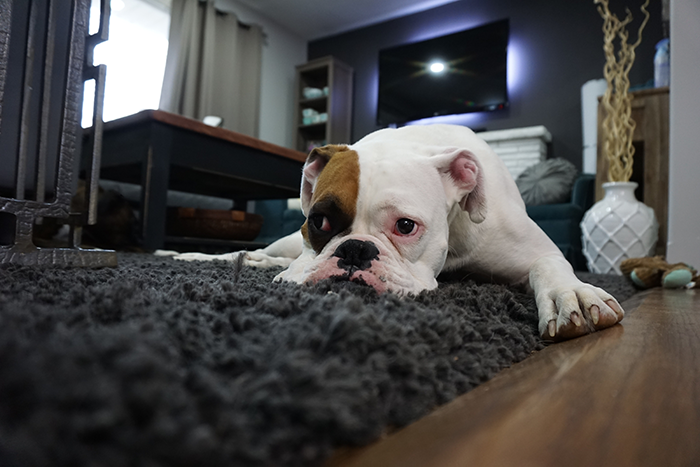How to Minimize the Risk of Pet Damage

Sponsored blog content provided by Rentometer
Tenants consider their cat or dog a furry family member, and most of them will pass on a property which isn't pet-friendly. That property might have everything they're looking for, with amazing amenities at an affordable price, but if Fido isn't allowed, they'll move on without a second thought. Compromise isn't an option.
Landlords have their own rationale, of course. Sharp claws and over-excitement cause considerable damage to hardwood flooring and drywall, and it only takes a week before the nice green lawn in front of a building is no longer nice or green. Maintenance expenses can exceed the profit accrued from a lenient policy.
Despite these difficulties, landlords don't have to turn away pet owners, and tenants don't have to give up their cat or dog. With a few adjustments to the lease, renovations to flooring and other changes, it's possible to reach an agreement where no one has to make a tough decision or inconvenient concession.
In this article, we'll walk landlords through the many ways they can minimize pet damage to preserve their properties while providing flexibility for tenants.
Contact Past Landlords
No two pet owners are the same. Some have a well-trained dog, but they fail to properly care for them, neglecting to walk, groom or clean up after their furry friend. Others have a dog which isn't as easy to care for, but the owner is aware of their obligations and doesn't ignore their responsibilities as a tenant.
When evaluating potential tenants, it's advisable to contact past landlords and hear what they have to say. The applicant could have a history of taking full responsibility for their animal. They might also be known to let their cat or dog do whatever it wants, wherever it wants.
Adjust the Agreement
When deciding to rent to tenants with pets, a landlord has to ensure these pets meet certain criteria. They're placing their property at risk if they take a carefree approach to the subject, and failing to include stipulations in the lease could lead to severe damage down the line. These additions are simple.
The agreement should require tenants to spay or neuter their animal if they haven't already. It'll often make them more docile and less difficult to manage. Landlords should also request that cats and dogs receive the full range of vaccinations and have licenses and tags for easy identification if the animal gets lost.
Renovate Flooring
A landlord who renovates their flooring with the right materials can secure their property against pet damage. Though it's a comparatively large-scale adjustment, new flooring is often worth the price when considering the maintenance expenses involved in owning a pet-friendly rental. If you’re thinking about working on a unit, then pet-friendly features might be a good idea.
After researching the available range of materials, many landlords might choose laminate or tile. These have qualities which make it ideal for pet owners, with high resistance to water and liquids, easy cleaning and the capacity to hide scratches. Vinyl is another great choice, as it reduces the amount of allergens which escape into the air.
Charge a Pet Deposit
Most states allow a landlord to charge a monthly pet fee or request a special deposit for tenants with a cat or dog. In other states, it's illegal to charge an additional fee. Landlords are never permitted to charge fees or deposits for tenants with service or companion animals. Research on state laws is necessary.
If the state doesn't have an issue with extra charges, landlords should consider a refundable pet deposit of $200 to $300. While making a rental pet-friendly has the potential to cause damage, the owner can mitigate risk by providing a financial incentive for good behavior. It's a small but effective change.
Work Out the Details
Cats and dogs are popular choices among pet owners, but hamsters, gerbils, rabbits, birds, fish and reptiles are also common. Landlords need to specify which animals they allow on their property, as ambiguous terms in the lease agreement could cause conflict later on. Working out the details of the pet policy is essential. Landlords might choose, for example, to ban animals they perceive as dangerous.
The policy should also include the maximum number of animals a tenant can have in their unit. Limiting ownership to one dog or one cat, two hamsters or two birds per tenant will reduce risk and maintenance expenses over time.
Everyone Benefits
Landlords shouldn't have to pay for excessive pet damage, and tenants shouldn't have to surrender their animals. Fortunately, by following the five suggestions above, landlords can have pet-friendly properties without the risk. Creating pet-friendly rental units using these tips will help keep both landlords and tenants — as well as their pets — happy.
Many of the suggestions in this article aren't costly or difficult to implement. Landlords should review their options today.
About the Author: Holly Welles covers real estate topics for the up-and-coming renter or homeowner. She runs her own blog, The Estate Update, and can also be found dishing up advice over on Twitter @HollyAWelles.

